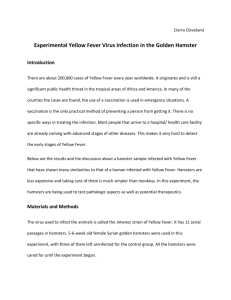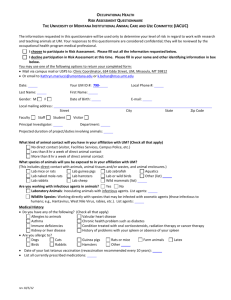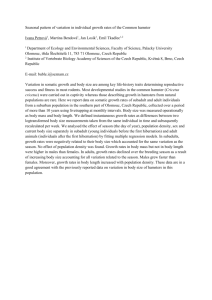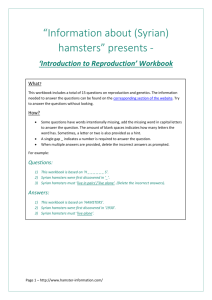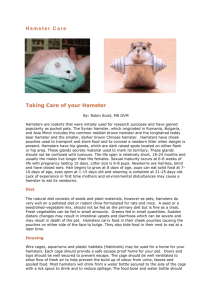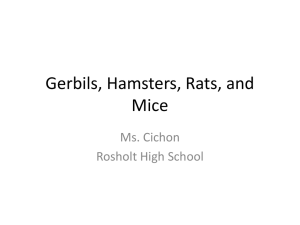Hamsters - One Stop Country Pet Supply
advertisement
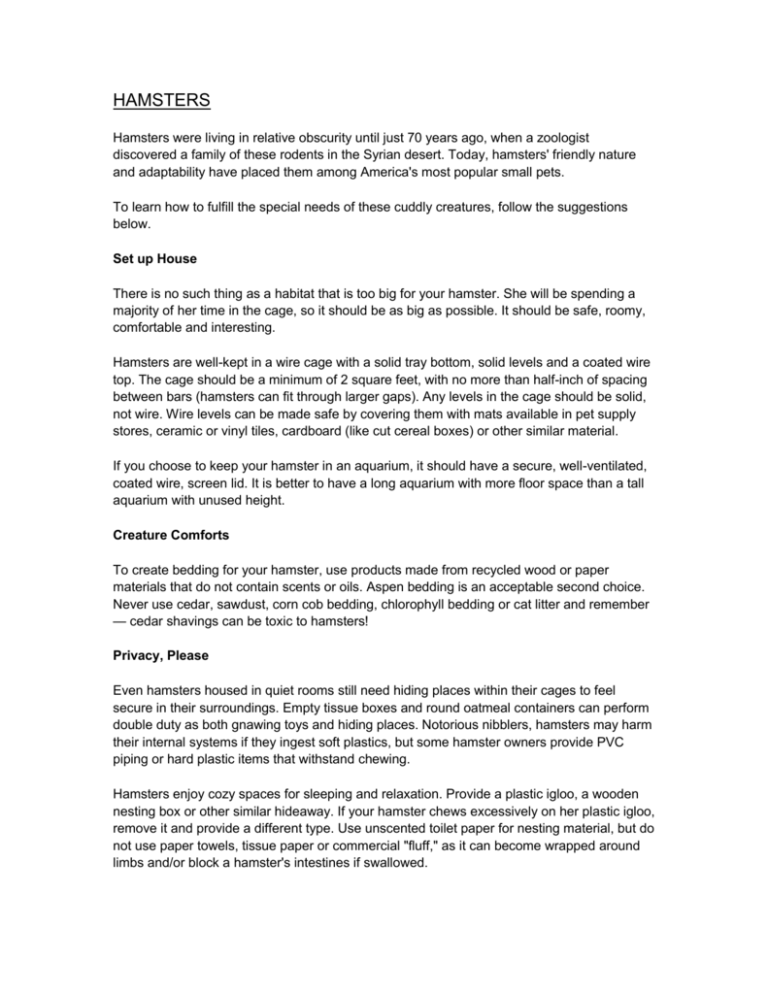
HAMSTERS Hamsters were living in relative obscurity until just 70 years ago, when a zoologist discovered a family of these rodents in the Syrian desert. Today, hamsters' friendly nature and adaptability have placed them among America's most popular small pets. To learn how to fulfill the special needs of these cuddly creatures, follow the suggestions below. Set up House There is no such thing as a habitat that is too big for your hamster. She will be spending a majority of her time in the cage, so it should be as big as possible. It should be safe, roomy, comfortable and interesting. Hamsters are well-kept in a wire cage with a solid tray bottom, solid levels and a coated wire top. The cage should be a minimum of 2 square feet, with no more than half-inch of spacing between bars (hamsters can fit through larger gaps). Any levels in the cage should be solid, not wire. Wire levels can be made safe by covering them with mats available in pet supply stores, ceramic or vinyl tiles, cardboard (like cut cereal boxes) or other similar material. If you choose to keep your hamster in an aquarium, it should have a secure, well-ventilated, coated wire, screen lid. It is better to have a long aquarium with more floor space than a tall aquarium with unused height. Creature Comforts To create bedding for your hamster, use products made from recycled wood or paper materials that do not contain scents or oils. Aspen bedding is an acceptable second choice. Never use cedar, sawdust, corn cob bedding, chlorophyll bedding or cat litter and remember — cedar shavings can be toxic to hamsters! Privacy, Please Even hamsters housed in quiet rooms still need hiding places within their cages to feel secure in their surroundings. Empty tissue boxes and round oatmeal containers can perform double duty as both gnawing toys and hiding places. Notorious nibblers, hamsters may harm their internal systems if they ingest soft plastics, but some hamster owners provide PVC piping or hard plastic items that withstand chewing. Hamsters enjoy cozy spaces for sleeping and relaxation. Provide a plastic igloo, a wooden nesting box or other similar hideaway. If your hamster chews excessively on her plastic igloo, remove it and provide a different type. Use unscented toilet paper for nesting material, but do not use paper towels, tissue paper or commercial "fluff," as it can become wrapped around limbs and/or block a hamster's intestines if swallowed. Stock the Pantry Hamsters have high metabolisms and should have constant access to food and water. Some hamsters like to sit in their food dishes, so use a heavy ceramic dish to decrease the likelihood of food spillage. Respect the hamster's need for order by placing the dish a good distance from the bathroom and sleeping areas. Hamsters need and benefit from a varied diet that includes small amounts of fresh vegetables, fruits, whole grains and protein sources. Hamsters enjoy a variety of fresh vegetables every day. Try asparagus, avocado, basil, broccoli, carrots, cauliflower, celery, cucumber, green pepper, okra, parsley, peas, red pepper, spinach and squash. Fresh fruit can be given as an occasional treat to Syrian hamsters, but not to dwarf hamsters, who are prone to diabetes. Syrian hamsters often enjoy apples, bananas, blueberries, cherries (pitted), cranberries, grapes, kiwi, melon, peaches, pears and strawberries. Hamsters may also enjoy (in small quantities) whole oats, spray millet, whole wheat bread, pumpkin seeds, flax seeds, tofu and hard-boiled or scrambled egg. Use common sense when feeding your hamster and introduce new foods slowly. Things to avoid feeding your hamster include iceberg lettuce, dried corn, raw beans, potato eyes, green potato, green parts of tomatoes, garlic, chocolate, processed foods and any sugary or salty foods. You can give your hamster natural wood chews that have not been artificially colored and/or dried apple branches from apple trees that have not been sprayed with pesticides. Wet Their Whistles To ensure that your hamster has an adequate water supply, use a hanging water bottle that has an angled stainless steel sipper tube with a ball bearing in the spout. A glass water bottle is preferable, but a plastic water bottle is acceptable. Give your hamster fresh water every day. Keep Them Occupied In their native habitat, hamsters have to travel great distances to find food, a fact that explains domestic hamsters' need for lots of exercise. Exercise wheels can provide hamsters with a good bit of activity, but they should not be the only source of physical activity. For Syrian hamsters, the exercise wheel should be at least 8 inches in diameter and should provide a solid running surface. Complement the hamster's home gym and entertainment center with chewables such as a dog biscuit or pesticide-free twigs from beech trees, maples, willows, hazelnut bushes or fruit trees; these will also help keep the animal's incisors worn down. Cardboard boxes, toiletpaper rolls and paper-towel rolls are also safe for hamsters to burrow in, chew on and play with. Wooden ladders and branches fastened securely to the inside of the tank can help hamsters show off their climbing agility. Hamsters need time out of their cage every day. You can let them run around a hamsterproofed room, or you can use a large plastic tub as a playpen. Hamsters can easily escape fence-type playpens. Hamsters love to explore. They like anything they can climb in, on, over, under and through. Give your hamster toilet paper tubes, little boxes, bridges, blocks and other toys to check out and play with. Practice Good Housekeeping Hamsters can be cranky if disturbed during their daytime sleeping hours, so try cleaning, feeding and handling in the late afternoon or evening. Be sure to clean out the hamster's bathroom space between weekly full-cage cleanings. Hamsters like to amass treasure chests of tidbits, so check for stockpiles of perishable food. Also clean the water bottle and sipper tube daily to prevent buildup of food, algae and bacteria; check to be sure it is working properly as well. Dwarf hamsters often enjoy a dust bath a few times a week. The bathing dust/sand can be purchased online and at most pet supply stores. Put the dust or sand in a ceramic bowl in the exercise area instead of in cage. You can reuse the sand as long as it is clean and not soiled by urine, food, etc. Change all the bedding weekly, disinfecting the tank and letting it dry before laying down fresh bedding and replacing the hamster's chewing, nesting and climbing toys. To remove a hamster to clean her tank, you can hold a small box near her and she will probably run right in. Before you pick her up, make sure you have clean hands that do not smell like food, otherwise she might mistake your finger for a treat. Make sure she is fully awake and aware of your presence. Scoop her up slowly and gently using both hands and always hold her over a surface such as a tabletop in case she manages to wriggle out of your hands. Keep It Clean Don't forget to practice good hygiene with your hamster, just as you would with any pet. In rare cases, pet hamsters and mice have been linked to cases of salmonellosis, a bacterial infection that can be serious for young children and adults with weakened immune systems. Use plastic gloves when cleaning your pet’s cage, and make sure all family members wash their hands after handling your pet, especially before eating. Also, don’t keep your small animal’s cage in the kitchen or any other room where food is prepared. The information in this care sheet was gathered from the Humane Society of the United States’ website www.hsus.org


